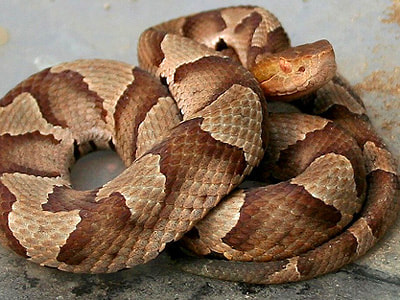Snakes become sluggish anywhere below 60 degrees° Fahrenheit (16° C). A steady temperature drop is a signal for the snake to enter brumation. The snake will become active again once the temperature rises back to about 60 degrees° Fahrenheit (16° C).
Since fall is now upon us, we still need to be diligent and have a watchful eye out for them when outside enjoying the cooler weather, especially when raking leaves, gathering firewood or hiking. Copperhead bites are quite common when raking leaves because they camouflage so well. Their coloration of different shades of brown makes them harder to discern among leaf debris. The Centers for Disease Control and Prevention estimates 7,000 to 8,000 snake bites yearly, mostly from these six species: the Western Diamondback Rattlesnake, Western Pygmy Rattlesnake, Timber Rattlesnake, Cottonmouth, Copperhead, and Coral snake. which has a neurotoxin in its venom. Hemotoxins destroy red blood cells, which also cause mechanical damage at the bite site, swelling, bruising, etc., whereas neurotoxins act on the nervous system, which is more lethal and destructive of nerve tissue. Treatment for snakebites has advanced over the years, as opposed to the old "cut and suck" snakebite kits where the victim would usually make an incision at the bite site and try to suck out any venom. Modern day emergency rooms have CroFab, a pharmaceutical-manufactured anti-venom that neutralizes the venom. They have other treatment options if you're injured by a "dry" bite where no venom was injected into the tissue, but leaves the tell-tale puncture wounds. Luckily the survival rate is extremely high these days thanks to anti-venom. It is extremely important to get to a medical facility as quickly as possible after you have been bitten! What should you do if you encounter a snake while hiking, raking leaves, or gathering firewood? Slowly back away from it. A snake only strikes in self-defense because you prod or step on them or have them cornered where they cannot crawl away and escape. Keep in mind that not all rattlesnakes will rattle a warning. They do have rattles that are audible when they coil up in a defensive posture, however, rattlesnakes don't always have time to get into that defensive posture, because they are stepped on or surprised. Therefore, many will strike without rattling. Snakes are generally farsighted and their inability to see close up is limited, which is why they strike when a threat is very close. There’s no need to be fearful of snakes and miss out on nice Fall weather, leaf peeping and yard chores — just be prepared by wearing protective snake gaiters or snake boots. Be alert and diligent when outside this time of year, and of course during warmer months, too. Comments are closed.
|
RAZER GAITERS

 RSS Feed
RSS Feed
